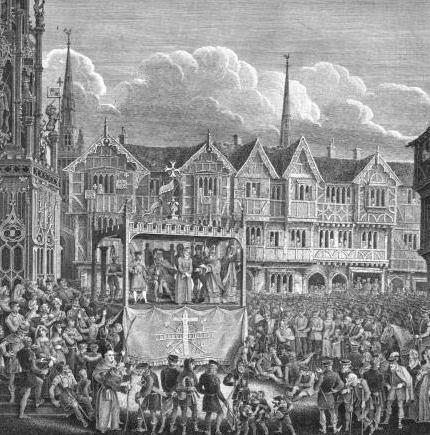Fourth in a series of excerpts from a magazine article in Belgravia, an Illustrated London Magazine, published in 1878. It describes the history of props in Western European theatrical traditions up to the late nineteenth century. I’ve split it into several sections because it is rather long and covers a multitude of subjects, which I will be posting over the next several days.
Stage Properties by Dutton Cook, 1878
A new performance being in course of preparation, the property-maker is duly furnished with a ‘plot’ or list of the articles required of his department, there being also plots or lists for the heads of other departments: a scene-painter’s plot, a carpenter’s scene plot, and a tailor’s plot, setting forth the dresses necessary to the representation. In the pantomime season, or whenever any great pageant or spectacle is to be produced, these plots are of prodigious extent. They are fairly written on long slips of paper—like the bills of fare in coffee-rooms—and may be some yards in length. The property-maker affixes his list to the wall of his workshop, and subjects it to very careful study. Every item must be considered and remembered. Here is the authentic property plot of the first three scenes of the famous pantomime of’ Mother Goose’:
- Scene I.—Thunder, &c.; stick for Mother Goose; favours for villagers; huntsman’s whip; staff for beadle.
- Scene II.—Golden egg; goose.
- Scene III.—Three chairs; a knife and stick for pantaloon; a sword for harlequin; two pistols to fire behind the scenes.
And so on through a score of scenes.
‘Mother Goose’ was really a very simple affair, however. The property plot of modern pantomimes is more after this fashion:
- Scene I.—Twelve demons’ heads; twelve three-pronged spears; twelve pairs demons’ wings; twelve tails; one dragon, to vomit fire, and with tail to move. One cauldron to burn blue; demon king’s head; one red-hot poker; four owls with movable eyes, to change to green imps; twelve squibs, to light on demons’ tails. Red fire.
- Scene II. Fairy Scene.—Twenty-four silver helmets for ballet, eight superior; twenty-four javelins for ditto, eight superior; twenty-four silver shields, eight superior; twenty-four garlands of flowers, eight superior; silver car for fairy queen, with silver star at back to revolve; Cupid’s bow and arrows; one dove, to fly off; one plum-pudding, to walk; six mince pies, to walk; one turkey and sausages to sing and dance. White fire.
The eight superior articles, it may be noted, are for the ladies in the front rank of the ballet, who are brought more prominently before the spectators, and are usually the more skilled and comely of the troop. At the back of the stage, inferiority of aspect and accomplishment, and the evidences of time’s assaults and injuries, are supposed to escape observation.
The duties of the property-man are very multifarious. Is a snow-storm required? He provides the snow, and showers or drifts it from the flies. Are figures or objects to be seen crossing the distant landscape, the river or the bridge? He cuts them out of pasteboard and fits them with wires that may be jerked this way and that. Does the situation require a railway collision, a burning house, a sinking ship, or an earthquake? The property-man will take the order and promptly execute it. Steam shall be seen to issue from funnels, engines shall shriek, mines shall explode, waves shall mount, flames flicker, lightnings flash and thunder roar, rafters fall, and sparks and smoke and fearful saltpetrous fumes fill the theatre—all at the bidding of the property-man.
(Dutton Cook. “Stage Properties.â€Â Belgravia, vol. 35. 1878: pp. 289-290.)

